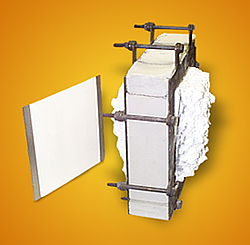Oct 3 2008
In a high-temperature blaze, how well does a fireproofing material shield a building’s important steel structures from heat? Answering this question has been surprisingly difficult, but it is important information for builders selecting high-performance fire-resistive materials and for scientists conducting computer simulations that investigate fires. Now, researchers at the National Institute of Standards and Technology (NIST) and their colleagues have developed a technique for measuring a key thermal property of fire-resistive materials at high temperatures. The measurement technique has already been adopted commercially and incorporated into a national standard.
 Experimental setup of Slug Calorimetry Method: Fireproofing material of interest sandwiches a platelike steel slug. Measuring heat flow through the slug can provide information on the thermal conductivity of the material.
Experimental setup of Slug Calorimetry Method: Fireproofing material of interest sandwiches a platelike steel slug. Measuring heat flow through the slug can provide information on the thermal conductivity of the material.
In creating computer simulations to study the collapses of the World Trade Center buildings on Sept. 11, 2001, NIST researchers needed to know important properties of the fireproofing materials that protected structural steel columns. One key property was the thermal conductivity of the material: How quickly does heat transfer through it? Thermal insulation has a low thermal conductivity and metals have a high thermal conductivity. There are long-established methods for measuring thermal conductivity under ambient conditions, but a material’s thermal conductivity can change markedly when it is subjected to extremely high temperatures that cause important chemical and structural changes. Traditional methods for measuring thermal conductivity at high temperatures have not been adequate. They have relied on “hot wire” techniques, which use wire probes to measure heat flow through a wire surrounded by the material of interest. At sufficiently elevated temperatures, the material can separate from the wire preventing the measurement of the thermal conductivity in a highly heated material.
NIST’s Dale Bentz and his colleagues developed a “slug calorimeter” technique for obtaining the thermal conductivity information at elevated temperatures. In this technique, they use a thin square slab of steel material known as a slug and sandwich it between slabs of the fireproofing material of interest. Guard insulation surrounds the sides of the sample so that heat flows preferentially through the sandwich when it is placed in a high-temperature furnace. Three temperature probes inserted into the steel slug measure the heat flowing to the steel. Combining this data with the known heat capacities and densities of the steel slug and the fire-resistive material, the researchers can determine the material’s thermal conductivity at various temperatures.
Following the successful demonstration of this method at NIST, two large U.S. testing labs have worked with NIST to develop their own in-house slug calorimeters as a testing service to their clients, and a third U.S. company recently introduced a commercial version of a slug calorimeter. ASTM International (formerly the American Society for Testing and Materials) has published a standard (ASTM E 2584) detailing how to conduct thermal conductivity measurements with the new method. Possible applications beyond steel fireproofing material, Bentz says, involve measuring the thermal conductivity of wood-based materials, as well as the insulating materials used to protect spacecraft such as the Space Shuttle.